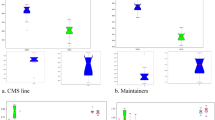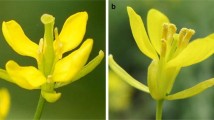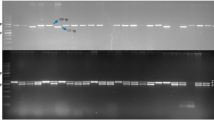Abstract
Cytoplasmic male-sterility (CMS) is the primary source for the production of commercially viable onion F1 hybrids. The molecular interplay of the cytoplasmic-nuclear genes propels the restoration of fertility in the CMS system, making it cost-effective and stable. The use of the molecular markers that can determine the cytoplasm type and nuclear genotype reduces the amount of time and labour required. This study characterized the morphology of male sterile and fertile plants based on anther colour and pollen viability. Additionally, the molecular characterization of the organellar DNA differentiating cytoplasm and nuclear genotypes in 35 commercially grown open-pollinated varieties of Indian short-day onion was attempted. Our results revealed that morphological and microscopic observations for the identification of male sterile and fertile plants were not 100% corroborative. Markers located in the chloroplast (accD) and mitochondrial DNA (MKFR) revealed that Indian cultivars exhibited a greater frequency of N (normal) cytoplasm, lower frequency of S (sterile) cytoplasm and no occurrence of T (sterile) cytoplasm. All three markers viz., AcPMS1, AcSKP1, and jnurf13 revealed that 93 to 99% of the plants of all the varieties had homozygous recessive (msms) alleles at the Ms locus. The OPT marker classified the plants as having 38% msms, 39% Msms and 21% MsMs genotypes and needs further investigation. This underscores the pressing need for additional markers to precisely discern the Ms locus, facilitating the identification of male sterile and maintainer plants within open-pollinated populations of Indian short-day onions. Notably, male sterile cytoplasm was identified in eight commercial varieties, marking a pioneering revelation in Indian onion cultivation.




Similar content being viewed by others
Data availability
The datasets generated during and/or analysed during the current study are available from the corresponding author upon reasonable request.
References
Bang H, Cho DY, Yoo KS, Yoon MK, Patil BS, Kim S (2011) Development of simple PCR-based markers linked to the Ms locus, a restorer-of-fertility gene in onion (Allium cepa L.). Euphytica 179:439–449
Brewster JL (2008) Onions and other vegetable alliums (No. 15). CABI
Chaurasia AK, Adsul GG, Nair D, Subramaniam VR, Krishna B, Sane PV (2010) Diversity in Indian and some exotic onion cultivars as revealed by genomic and mitochondrial DNA. Acta Hortic 859:207–220
FAOSTAT (2023) Onion production, area and productivity. https://www.fao.org/faostat/en/#data/QCL.Accessed on 13 Feb 2024
Gokce AF, Havey MJ (2002) Linkage equilibrium among tightly linked RFLPs and the Ms locus in open pollinated onion populations. J Am Soc Hortic Sci 127:944–946
Havey MJ (1995) Identification of cytoplasms using the polymerase chain reaction to aid in the extraction of maintainer lines from open-pollinated populations of onion. Theor Appl Genet 90:263–268
Havey MJ (2000) Diversity among male-sterility-inducing and male-fertile cytoplasms of onion. Theor Appl Genet 101:778–782
Havey MJ (2013) Single nucleotide polymorphisms in linkage disequilibrium with the male-fertility restoration (Ms) locus in open-pollinated and inbred populations of onion. J Am Soc Hortic Sci 138:306–309
Havey MJ, Kim S (2021) Molecular marker characterization of commercially used cytoplasmic male sterilities in onion. J Am Soc Hortic Sci 146:351–355
Havey MJ, Von Kohn C (2017) Efficacy of molecular markers jnurf13 and AcPms1 for prediction of genotypes at the nuclear Ms locus in North American open pollinated populations of onion. Hortic Sci 52:1052–1053
Huo YM, Liu BJ, Yang YY, Miao J, Gao LM, Kong SP, Wang ZB, Kitano H, Wu X (2015) AcSKP1, a multiplex PCR based co-dominant marker in complete linkage disequilibrium with the male-fertility restoration (Ms) locus, and its application in open pollinated populations of onion. Euphytica 204:711–722
Jones HA, Clarke A (1943) Inheritance of male sterility in the onion and the production of hybrid seed. J Am Soc Hortic Sci 43:189–194
Jones HA, Emsweller SL (1936) A male-sterile onion. J Am Soc Hortic Sci 34:582–585
Khar A (2022) Molecular breeding in allium. Edible alliums-botany, production and uses (Rabinowitch HD and Thomas B). CABI Publishing, UK, pp 284–295
Khar A, Saini N (2016) Limitations of PCR-based molecular markers to identify male-sterile and maintainer plants from Indian onion (Allium cepa L.) populations. Plant Breed 135:519–324
Khar A, Zimik M, Verma P, Singh H, Mangal M, Singh MC, Gupta AJ (2022) Molecular marker-based characterization of cytoplasm and restorer of male sterility (Ms) locus in commercially grown onions in India. Mol Biol Rep 49:5535–5545
Kim S (2014) A codominant molecular marker in linkage disequilibrium with a restorer-of-fertility gene (Ms) and its application in re-evaluation of inheritance of fertility restoration in onions. Mol Breed 34:768–778
Kim S, Lee E, Cho DY, Han T, Bang H, Patil BS, Ahn YK, Yoon M (2009) Identification of a novel chimeric gene, orf725, and its use in development of a molecular marker for distinguishing among three cytoplasm types in onion (Allium cepa L.). Theor Appl Genet 118:433–441
Kim S, Kim CW, Park M, Choi D (2015) Identification of candidate genes associated with fertility restoration of cytoplasmic male-sterility in onion (Allium cepa L.) using a combination of bulked segregant analysis and RNA-seq. Theor Appl Genet 128:2289–2299
Lee HI, Havey MJ (2020) Variable penetrance among different sources of the male fertility restoration allele of onion. Hortic Sci 55:543–546
Murray MG, Thompson WF (1980) Rapid isolation of high molecular weight plant DNA. Nucleic Acids Res 8:4321–4326
Netrapal N, Narendra Singh NS (1999) Heterosis for yield and storage parameters in onion (Allium cepa L.). Indian J Agric Sci 69:826–829
Nunes RLC, Oliveira ABD, Dutra AS (2014) Agronomic performance of onion hybrids in Baraúna, in the semi-arid region of Brazil. Rev Ciênc Agron 45:606–611
Pathak CS (1997) A possible new source of male sterility in onion. Acta Hortic 433:313–316
Pathak CS, Singh DP, Deshpande AA (1980) Annual Report, IIHR, Bangalore, pp 34–36
Peterson R, Janet P, Slovin CC (2010) A simplified method for differential staining of aborted and non-aborted pollen grains. Int J Plant Biol 1:e13
Pike LM (1986) Onion Breeding. In: Publishing AVI (ed) Breeding vegetable crops. Basset MJ. Co., Inc., Westport, Connecticut, pp 357–394
Saini N, Hedau NK, Khar A, Yadav S, Bhatt JC, Agrawal PK (2015) Successful deployment of marker assisted selection (MAS) for inbred and hybrid development in long-day onion (Allium cepa L.). Indian J Genet Plant Breed 75:93–98
Santos CAF, Leite DL, Oliveira VR, Rodrigues MA (2010) Marker-assisted selection of maintainer lines within an onion tropical population. Sci Agric 67:223–227
Sato Y (1998) PCR amplification of CMS-specific mitochondrial nucleotide sequences to identify cytoplasmic genotypes of onion (Allium cepa L.). Theor Appl Genet 96:367–370
Schweisguth B (1973) E ́ tude d’un nouveau type de sterilite ́ male chez l’oignon, Allium cepa L. Ann Ame ́lior Plant 23:221–233
Shashikanth Evoor SE, Gowda RV, Gangappa E, Monohar RK (2007) Heterosis for yield, yield components and quality traits in onion (Allium cepa L.). Karnataka J Agric Sci 20:813–815
Shishova M, Puzanskiy R, Gavrilova O, Kurbanniazov S, Demchenko K, Yemelyanov V, Pendinen G, Shavarda A, Gavrilenko T (2019) Metabolic alterations in male-sterile potato as compared to male-fertile. Metabolites 9(2):24. https://doi.org/10.3390/metabo9020024
Singh RK, Bhonde SR (2011) Performance studies of exotic onion (Allium cepa L.) hybrids in the Nasik region of Maharashtra. Indian J Hill Farming 24:29–31
Von Kohn C, Kiełkowska A, Havey MJ (2013) Sequencing and annotation of the chloroplast DNAs and identification of polymorphisms distinguishing normal male-fertile and male-sterile cytoplasm of onion. Genome 56:737–742
Wu Y, Min L, Wu Z et al (2015) Defective pollen wall contributes to male sterility in the male sterile line 1355A of cotton. Sci Rep 5:9608. https://doi.org/10.1038/srep09608
Funding
This work was financially supported by a research grant awarded under the Core Research Grant-Science and Engineering Research Board (CRG-SERB) Scheme, Government of India (CRG/2019/006525) awarded to the corresponding author.
Author information
Authors and Affiliations
Contributions
HS was responsible for the layout of the trial, field work, data collection and writing of the first draft. Dr MZ was responsible for DNA isolation, marker validation and molecular analysis. Dr MM, KG, SS contributed to the formulation and guidance of the research and manuscript editing. Dr AK is the supervisor of this research paper, and he contributed to the development of the concept, guided the research, wrote and edited the manuscript critically for publication. Finally, all the authors contributed to the final approval of the version to be published. Hence, before submission for publication, all the authors have read and approved the final manuscript.
Corresponding author
Ethics declarations
Competing interests
The authors have no competing interests to declare that are relevant to the content of this article. The authors have no financial or proprietary interests in any material discussed in this article.
Additional information
Publisher's Note
Springer Nature remains neutral with regard to jurisdictional claims in published maps and institutional affiliations.
Supplementary Information
Below is the link to the electronic supplementary material.
Rights and permissions
Springer Nature or its licensor (e.g. a society or other partner) holds exclusive rights to this article under a publishing agreement with the author(s) or other rightsholder(s); author self-archiving of the accepted manuscript version of this article is solely governed by the terms of such publishing agreement and applicable law.
About this article
Cite this article
Singh, H., Zimik, M., Mangal, M. et al. Distribution pattern of cytoplasm and restoration of male fertility (Ms) locus in short-day tropical Indian onion populations. Euphytica 220, 70 (2024). https://doi.org/10.1007/s10681-024-03334-1
Received:
Accepted:
Published:
DOI: https://doi.org/10.1007/s10681-024-03334-1




